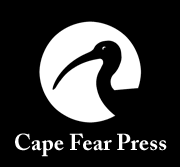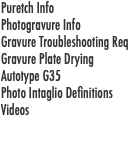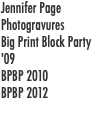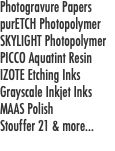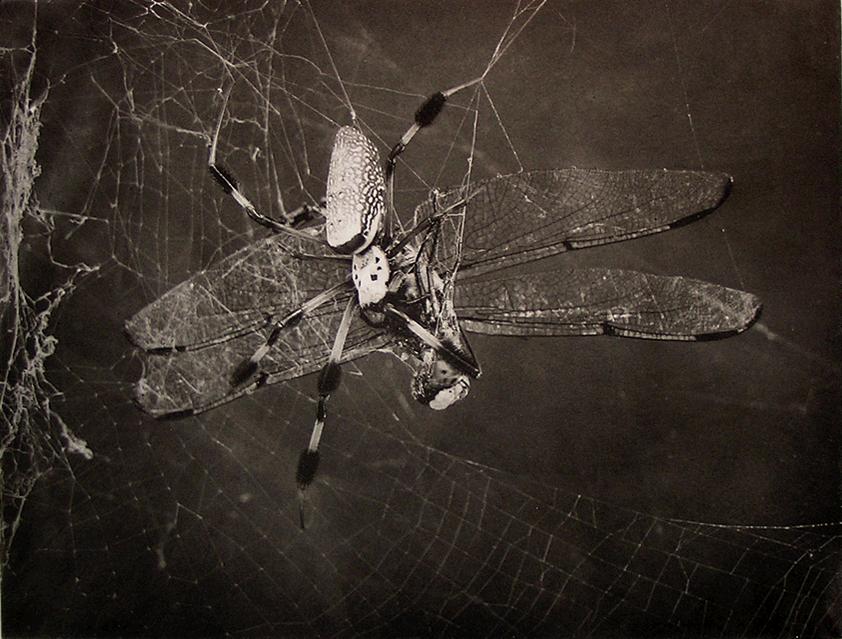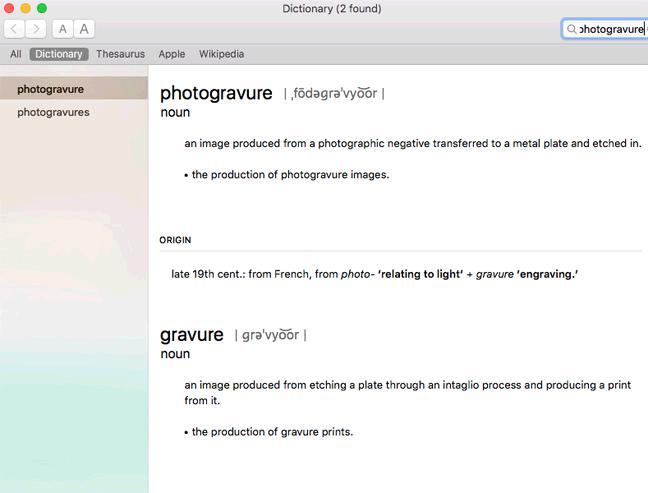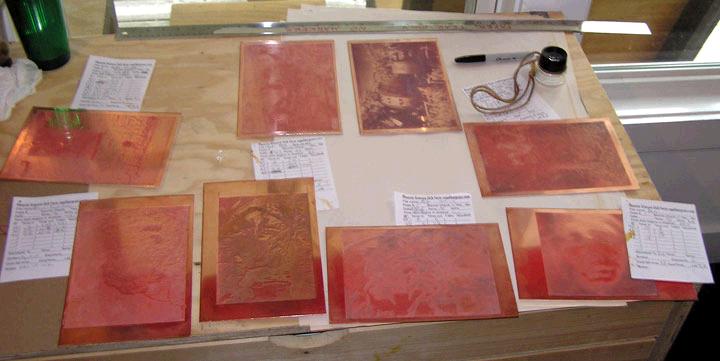WHAT IS A PHOTOGRAVURE?
and other Photo Intaglio Definitions
The goal of this page is to educate people (including artists, teachers, students, curators, collectors and dealers) to the main differences in the various types of photo intaglio printing processes. It is my hope that people will use the appropriate term when describing the processes or medium of these prints. The public already knows too little about these processes so it is important that they are not further confused or misled when looking at prints or learning a process. The term photogravure has been deliberately usurped by many working in photopolymer for marketing purposes. The two processes are extremely different and the burden should lie on those working with newer processes to distinguish their work clearly and transparently. These simple terms serve to quickly and efficiently describe exactly how a photo intaglio plate and print was made. Correct terms with alternates are in bold for each category. Fine Art Photo Intaglio Processes Photogravure (see photogravure plates in the photo below)
Photogravure is a 19th century process of etching continuous tones into copper using a photographic gelatin resist. The process was invented by William H. F. Talbot and Karel Klic in 1879 and was born out of Talbot's photoglyphic engraving process and the carbon transfer printing process that was invented in in the mid 1800s by Poitevin and refined by Swan. Talbot and Klic used both lined screens and bitumen aquatint to create the tooth necessary to hold ink in the etched plate. Dichromate sensitized gelatin has a straight line UV sensitivity response which makes it the most capable of reproducing the full range of tones and detail in the continuous tone film positive. The iron oxide red pigmented gelatin tissue is sensitized and exposed to a continuous tone positive and transferred to the copper and developed in hot water. The tones are imparted inversely to the gelatin negative image on the plate which is varied in thickness acts as an etching resist. The etch begins in the shadows which is the thinnest followed by lighter shadows, the midtones and lastly the highlight tones, all etching in proportionate depth to their respective densities. This continually self staged resist yields an etched plate that will print with a varying depth layer of ink. Careful timing of the different etching baths also adds another way of controling or manipulating the tonal curves and maximizing the tonal range of the image. The gravure process yields an etched plate that can be retouched and re-worked with any of the traditional etching processes. The copper plate is often electroplated with iron (steel faced) for printing very consistent and/or long editions.
Photogravure is also referred to as 'Gravure' or 'Heliogravure'. When a drawing on mylar or vellum is used instead of a photgraphic positive the print is known as a 'Direct Gravure'. Photo Etching / Photo Engraving
This process dates back to 1822 when Niepce coated copper and tin plates with a bitumen varnish and made long exposures with transluscent drawings in the sun. The exposed varnish was washed out with a solvent and the remaining image stencil was etched in acid. In 1852 Talbot made photoglyphic engravings from metal plates coated with dichromated fish glue that were exposed to the sun and etched in ferric chloride. The process is essentially the same today where a metal plate, usually copper or zinc, is coated with a high contrast, negative working photo-sensitive resist such as KPR or sensitized fish glue or a thin film photopolymer such as Puretch. The photo resist is exposed to a very fine halftone positive or high contrast line image. A halfone creates an illusion of tone by using tiny black dots of varying size and distance. Halftones are made digitally now with inkjet, laser printers or imagesetters. If an aquatint is required for any large areas of solid black it can be done traditionally with dustgrain or spray, with a separate screen exposure or built in digitally. The plate is developed with a solvent or mild alkaline producing a high resolution etching resist. This process yields a plate that can be etched to the desired depth and tone. In photo etching all of the exposed plate and dots will receive the same amount of etch unless manually staged out by the artist. The photo resist is usually stripped before printing and the etched plate can be retouched and re-worked afterwards with any of the traditional etching processes. Some artists are using gelatin pigment paper (see Photogravure above) for exposure and etching of fine halftones. Because of the nature of etching a halftone or high contrast image, these prints are more akin to photo etching versus a continuous tone photogravure.
A Photo-Etching can also correctly be labeled Photo-Engraving or simply 'Etching'. Photopolymer Intaglio
Photopolymer intaglio is a process developed in the late 20th century and has become much more refined in the last 10 few years. It is a non-etch process of making a photo intaglio printing matrix of photopolymer. Plates are either manually coated with a thick photopolymer film such as Skylight photopolymer or they are available as pre-coated flexographic plates. Plates laminated with film are typically exposed with a very fine halftone positive that has a grain built into the blacks. Pre-coated plates can be exposed with the halftone method or with a continuous tone positive which requires a separate exposure to an aquatint screen. The plates are developed in water or a mild alkaline solution which washes away the unhardened photopolymer creating fine recessed crevices for the ink. The photopolymer film and plates adapted here for fine art intaglio printing were designed for high contrast exposure response and print applications. Therefore the photopolymer emulsion is inherently not as sensitive to the full range of tones that photogravure gelatin resist is capable of reproducing. A more recent development with photopolymer is Computer To Plate printing (CTP) or Direct To Plate (DTP) printing. The image is printed directly onto the emulsion and in most every case is printed with an extremely fine halftone that receives only one exposure to UV light. 'Photopolymer Intaglio' is also correctly known as 'Photopolymer'. These descriptions can also be used when positives are hand drawn on mylar. The 'Photopolymer Intaglio' process is often incorrectly referred to as 'Photogravure', 'Photopolymer Gravure' or 'Polymer Gravure'. The inclusion of the word gravure here is misleading since there is no etching or engraving involved, there is only developing. (See Oxford definitions for photogravure and gravure below) A print made with any of the processes above could be called Photo Intaglio or simply Intaglio but when the description is more specific then the term should accurately reflect the process used. ©2011-2022 capefearpress Below: Screenshot from the Mac New Oxford American Dictionary App.
| 